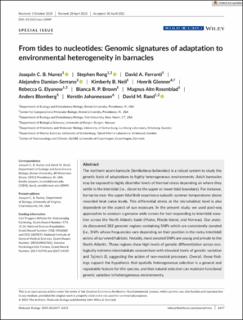| dc.contributor.author | Glenner, Henrik | |
| dc.contributor.author | Nunez, Joaquin C.B. | |
| dc.contributor.author | Rong, Stephen, | |
| dc.contributor.author | Ferranti, David A. | |
| dc.contributor.author | Damian-Serrano, Alejandro | |
| dc.contributor.author | Neil, Kimberly B. | |
| dc.contributor.author | Elyanow, Rebecca G. | |
| dc.contributor.author | Brown, Bianca R. P. | |
| dc.contributor.author | Rosenblad, Magnus Alm | |
| dc.contributor.author | Blomberg, Anders | |
| dc.contributor.author | Johannesson, Kerstin | |
| dc.contributor.author | Rand, David M. | |
| dc.date.accessioned | 2022-04-06T08:19:29Z | |
| dc.date.available | 2022-04-06T08:19:29Z | |
| dc.date.created | 2021-09-11T19:41:54Z | |
| dc.date.issued | 2021 | |
| dc.identifier.issn | 0962-1083 | |
| dc.identifier.uri | https://hdl.handle.net/11250/2990085 | |
| dc.description.abstract | The northern acorn barnacle (Semibalanus balanoides) is a robust system to study the genetic basis of adaptations to highly heterogeneous environments. Adult barnacles may be exposed to highly dissimilar levels of thermal stress depending on where they settle in the intertidal (i.e., closer to the upper or lower tidal boundary). For instance, barnacles near the upper tidal limit experience episodic summer temperatures above recorded heat coma levels. This differential stress at the microhabitat level is also dependent on the aspect of sun exposure. In the present study, we used pool-seq approaches to conduct a genome wide screen for loci responding to intertidal zonation across the North Atlantic basin (Maine, Rhode Island, and Norway). Our analysis discovered 382 genomic regions containing SNPs which are consistently zonated (i.e., SNPs whose frequencies vary depending on their position in the rocky intertidal) across all surveyed habitats. Notably, most zonated SNPs are young and private to the North Atlantic. These regions show high levels of genetic differentiation across ecologically extreme microhabitats concomitant with elevated levels of genetic variation and Tajima's D, suggesting the action of non-neutral processes. Overall, these findings support the hypothesis that spatially heterogeneous selection is a general and repeatable feature for this species, and that natural selection can maintain functional genetic variation in heterogeneous environments. | en_US |
| dc.language.iso | eng | en_US |
| dc.publisher | Wiley | en_US |
| dc.rights | Navngivelse-Ikkekommersiell 4.0 Internasjonal | * |
| dc.rights.uri | http://creativecommons.org/licenses/by-nc/4.0/deed.no | * |
| dc.title | From tides to nucleotides: Genomic signatures of adaptation to environmental heterogeneity in barnacles | en_US |
| dc.type | Journal article | en_US |
| dc.type | Peer reviewed | en_US |
| dc.description.version | publishedVersion | en_US |
| dc.rights.holder | Copyright 2021 The Author(s) | en_US |
| cristin.ispublished | true | |
| cristin.fulltext | original | |
| cristin.qualitycode | 2 | |
| dc.identifier.doi | 10.1111/mec.15949 | |
| dc.identifier.cristin | 1933485 | |
| dc.source.journal | Molecular Ecology | en_US |
| dc.source.pagenumber | 6417-6433 | en_US |
| dc.identifier.citation | Molecular Ecology. 2021, 30 (23), 6417-6433. | en_US |
| dc.source.volume | 30 | en_US |
| dc.source.issue | 23 | en_US |

